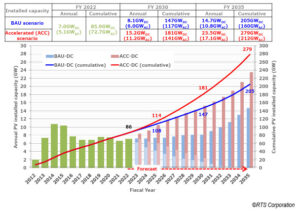Since 2020, the introduction of PV power generation has been accelerated globally to create a decarbonized society and as a measure to strengthen responses to energy security triggered by Russia’s invasion of Ukraine, and the annual PV installed capacity is about to reach 300 GW.
PV power generation in Japan has progressed from being introduced under the “Sixth Strategic Energy Plan” and “Global Warming Countermeasures Plan” to being introduced under the “GX Promotion Strategy” (GX refers to Green Transformation) approved by the Cabinet based on the “Basic Policy for the Realization of GX”, and the government is committed to making all out efforts to ensure the achievement of the renewable energy ratio of 36 to 38% by FY 2030. The Ministry of Economy, Trade and Industry (METI), the Ministry of the Environment (MoE) and other relevant ministries and agencies are poised to expand the introduction of renewable energy by mobilizing all the policy measures, laws, regulatory reforms, budgets, development, etc. technological under their jurisdictions toward the realization of GX. In the FY 2024 budget request, a large amount has been allocated for expanding the introduction of renewable energy such as PV power generation as a measure to promote GX.
As the relevant ministries and agencies promote the introduction and deployment of PV power generation, assuming that the costs of PV power generation and storage batteries will decline reflecting international prices and the introduction of these renewable energy sources in harmony with local communities will progress, RTS Corporation made forecasts on the PV installed capacity in Japan through to 2035, based on the FY 2022 results. The annual PV installed capacity is estimated to gradually increase from 7 GWDC to 8.1 GWDC (6.0 GWAC) by 2030, and 147 GWDC (117 GWAC) on the cumulative basis under the BAU (Business As Usual) scenario, which is equivalent to the government’s introduction target. Furthermore, the PV installed capacity will grow to 14.7 GWDC (10.8 GWAC) annually and 205 GWDC (160 GWAC) cumulatively in 2035.
Toward FY 2030, the introduction of PV power generation will develop through the standardization of the PV introduction and the formation of a stable market from 2030 to 2035 due to the continuation of various support measures by the national and local governments, the introduction of PV power generation for self-consumption due to rising electricity bills, the increase in the number of consumers seeking green power with an awareness of decarbonized management, and the lowering of hurdles to introduction due to the penetration of the PPA scheme.
Meanwhile, under the accelerated (ACC) scenario, or a scenario in consideration of the factors accelerating the PV introduction, it is expected that the ratio of renewable energy in the energy mix will be revised upward due to further strengthening of energy security and acceleration of climate change countermeasures. Thus, the new PV introduction will be promoted by policy measures and the mandatory PV installations will increase. Users of renewable energy electricity will spread from mainly large companies to the entire supply chain, including small and medium-sized enterprises (SMEs), and the research and development results of next-generation solar cell technology cultivated in the first half of the 2020s will expand the social implementation of PV power generation to places where it is currently difficult to install PV systems.
Furthermore, with the spread of energy storage stations, electric vehicles (EVs), as well as V2H (Vehicle to Home) and V2G (Vehicle to Grid) due to further decreasing cost of power storage technology, supply and demand adjustment by aggregation and VPP, local production and local consumption of energy, will become common, and the challenges of PV power generation such as being a variable power source will be solved. The markets for multi-use PV power generation are expected to emerge, such as building-integrated PV (BIPV) that make multiple uses of land and space, PV integrated with infrastructure such as roads and railways, PV on farmland, and floating PV (FPV) systems. As a result, the annual installed capacity in FY 2030 is estimated to increase from about 7 GWDC today to 15.2 GWDC (11.2 GWAC) per year, and the cumulative installed capacity is forecasted to increase to 181 GWDC (141 GWAC). From 2030 onwards, grid constraints will be greatly improved by grid improvement and the development of dispatchable power sources, and farmland utilization will begin to progress, the annual and cumulative PV installed capacity in FY 2035 are expected to reach 23.5 GWDC (17.1 GWAC) and 279 GWDC (212 GWAC), respectively.
The installed capacity of PV systems under the FIT/FIP programs accounted for about 95% of the total in FY 2022, but the percentage is expected to gradually decrease in the future, and by the first half of the 2030s, almost all of the introduction are estimated to be made without relying on the FIT/FIP programs.
In order to expand the introduction of PV power generation, it is essential to reduce the cost of power generation to the international level, significantly improve social acceptance from the economy and society as a whole not just through achieving PV introduction in harmony with local communities, and to build sustainability that includes resource recycling as well as making PV a long-term stable power source. In addition, today’s PV industry, which is mainly based on new introductions, will deepen cooperation with industry, government, academia and financial critics,and as an energy industry that can provide a stable power supply of more than 100 billion kWh per year, it will be essential to strengthen the supply chain and expand the business domain, and to transform and develop into a future-oriented next-generation industry.

